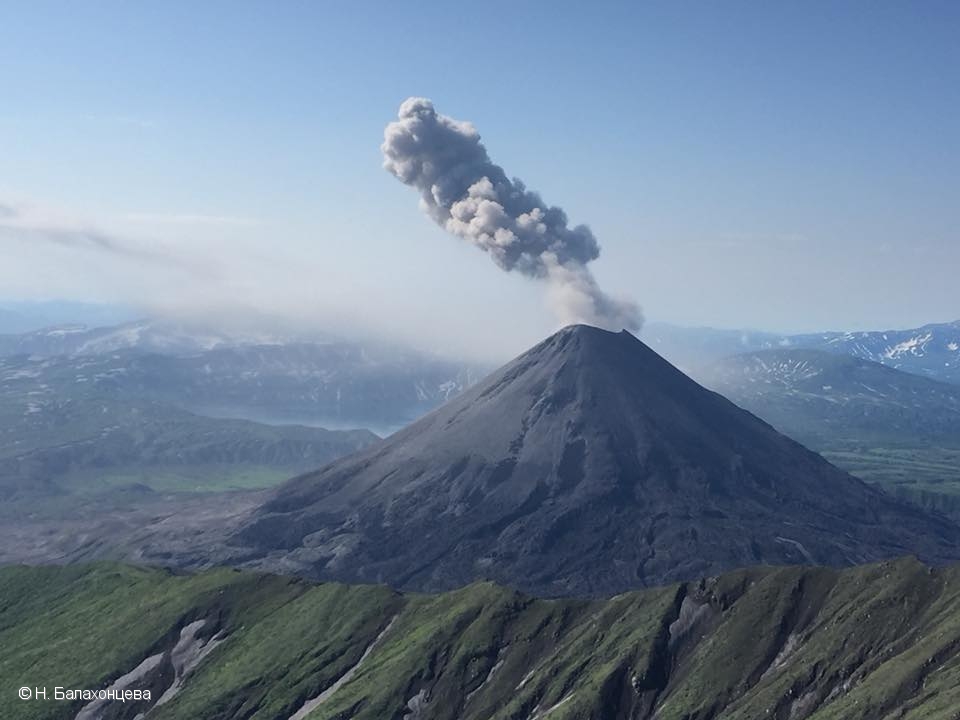Report on Karymsky (Russia) — August 2018
Bulletin of the Global Volcanism Network, vol. 43, no. 8 (August 2018)
Managing Editor: Edward Venzke.
Research and preparation by Sara Arav-Piper.
Karymsky (Russia) Renewed eruptive activity with ash plumes during April through July 2018
Please cite this report as:
Global Volcanism Program, 2018. Report on Karymsky (Russia) (Venzke, E., ed.). Bulletin of the Global Volcanism Network, 43:8. Smithsonian Institution. https://doi.org/10.5479/si.GVP.BGVN201808-300130
Karymsky
Russia
54.049°N, 159.443°E; summit elev. 1513 m
All times are local (unless otherwise noted)
Recent eruptive activity at Karymsky has consisted of moderate intermittent ash explosions during 5-8 October 2016 (BGVN 42:08) and 4 June 2017-27 January 2018 (BGVN 42:11, 43:04). Another eruptive period began on 28 April 2018, with thermal anomalies, gas-and-steam emissions, and ash plumes observed through July 2018. The Aviation Color Code (ACC) was raised from Yellow to Orange at the end of April when moderate explosive activity began. This report was compiled using information from the Kamchatka Volcanic Eruptions Response Team (KVERT).
Moderate explosive activity renewed in April 2018. An ash plume rose to 5.5 km and drifted 150 km on 28 April and 2-3 May to the NE and SE, respectively. On 14 May the ash plume drifted 150 km to the SW. The ACC was lowered to Yellow on 15 June. Weak gas, steam, and some ash plumes were again reported in 10 July. The Tokyo VAAC noted continuous ash seen in Himawari-8 satellite imagery on 12 July, with a plume extending E at 3.6 km altitude. Another ash advisory the VAAC noted an eruption seen at 2120 on 14 July (figure 38) that sent a plume to 7.6 km altitude and drifted S. Continuous ash observations were again cause for a VAAC notice on 16 July. An explosion on 17 July generated an ash plume that rose to 5 km and drifted 11 km WSW, which prompted raising the ACC back to Orange. Satellite images show an ash plume drifting 100 km to the SE on 20 July (figure 39). The ACC remained at alert level Orange.
 |
Figure 39. Aerial photograph showing explosive activity at Karymsky, 28 July 2018. Photo by N. Balakhontseva; courtesy of Institute of Volcanology and Seismology (IVS FEB RAS). |
Thermal anomalies were observed in satellite data and reported by KVERT on 11 April, 3, 13-15, 19-20 May, 8, 10-13-20, 25, 27-29, and 31 July 2018. The MODVOLC system reported six thermal anomalies during this period. The MODIS thermal anomalies detected by MIROVA during this reporting period were all low in intensity, with notable periods of increased activity in the first half of May and July 2018 (figure 40).
 |
Figure 40. MODIS thermal anomalies identified in the MIROVA system, plotted as log radiative power for the year ending 29 August 2018. Courtesy of MIROVA. |
Geological Summary. Karymsky, the most active volcano of Kamchatka's eastern volcanic zone, is a symmetrical stratovolcano constructed within a 5-km-wide caldera that formed during the early Holocene. The caldera cuts the south side of the Pleistocene Dvor volcano and is located outside the north margin of the large mid-Pleistocene Polovinka caldera, which contains the smaller Akademia Nauk and Odnoboky calderas. Most seismicity preceding Karymsky eruptions originated beneath Akademia Nauk caldera, located immediately south. The caldera enclosing Karymsky formed about 7600-7700 radiocarbon years ago; construction of the stratovolcano began about 2000 years later. The latest eruptive period began about 500 years ago, following a 2300-year quiescence. Much of the cone is mantled by lava flows less than 200 years old. Historical eruptions have been vulcanian or vulcanian-strombolian with moderate explosive activity and occasional lava flows from the summit crater.
Information Contacts: Kamchatka Volcanic Eruptions Response Team (KVERT), Far Eastern Branch, Russian Academy of Sciences, 9 Piip Blvd., Petropavlovsk-Kamchatsky, 683006, Russia (URL: http://www.kscnet.ru/ivs/kvert/); Institute of Volcanology and Seismology, Far Eastern Branch, Russian Academy of Sciences (IVS FEB RAS), 9 Piip Blvd., Petropavlovsk-Kamchatsky 683006, Russia (URL: http://www.kscnet.ru/ivs/eng/); MIROVA (Middle InfraRed Observation of Volcanic Activity), a collaborative project between the Universities of Turin and Florence (Italy) supported by the Centre for Volcanic Risk of the Italian Civil Protection Department (URL: http://www.mirovaweb.it/); Hawai'i Institute of Geophysics and Planetology (HIGP) - MODVOLC Thermal Alerts System, School of Ocean and Earth Science and Technology (SOEST), Univ. of Hawai'i, 2525 Correa Road, Honolulu, HI 96822, USA (URL: http://modis.higp.hawaii.edu/).


